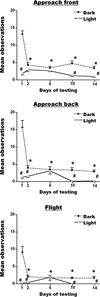Colony formation of C57BL/6J mice in visible burrow system: identification of eusocial behaviors in a background strain for genetic animal models of autism
- PMID: 16971001
- PMCID: PMC3264663
- DOI: 10.1016/j.bbr.2006.07.027
Colony formation of C57BL/6J mice in visible burrow system: identification of eusocial behaviors in a background strain for genetic animal models of autism
Abstract
Deficits in social interaction are primary characteristics of autism, which has strong genetic components. Genetically manipulated mouse models may provide a useful research tool to advance the investigation of genes associated with autism. To identify these genes using mouse models, behavioral assays for social relationships in the background strains must be developed. The present study examined colony formation in groups of one male and three female mice (Experiment 1) and, groups of three male mice (Experiment 2) of the C57BL/6J strain in a semi-natural visible burrow system. For adult mixed-sex colonies, 4-h observations during both the dark and light cycles for 15 days demonstrated day-dependent increases in huddling together in the chamber accompanied by decreased frequencies of active social behaviors. Sequential analyses of social interactions indicated that approaches to the back of the approached animal typically elicited flight, while approaches to the front of the approached animal failed to do so. This was seen for female to female, and for female to male approaches, as well as male to female approaches, strongly counterindicating a view that rear approach/flight specifically reflects female responsivirity to unwanted male sexual approach. For adult male colonies, similar protocols found that these social behaviors were similar to those of adult mixed-sex colonies. These findings suggest two potentially useful measures of eusocial behavior in mice, of possible value for genetic mouse models of autism; that is, huddling together and approaches to the front but not the back, of conspecifics.
Figures





References
-
- American Psychiatric Association. Diagnostic and statistical manual of mental disorders. 4th edition: DSM-IV. Washington, DC: American Psychiatric Association; 1994.
-
- Batchelder P, Kinney RO, Demlow L, Lynch CB. Effects of temperature and social interations on huddling behavior in Mus Musculus. Physiol Behav. 1983;31:97–102. - PubMed
-
- Blanchard RJ, Blanchard DC, Takahashi T, Kelley ML. Attack and defensive behaviour in the albino rat. Anim Behav. 1977;25:622–634. - PubMed
-
- Blanchard RJ, O’Donnell V, Blanchard DC. Attack and defensive behaviors in the albino mouse. Aggress Behav. 1979;5:341–352.
Publication types
MeSH terms
Grants and funding
LinkOut - more resources
Full Text Sources

